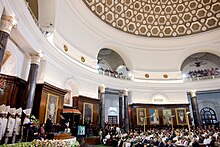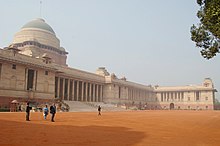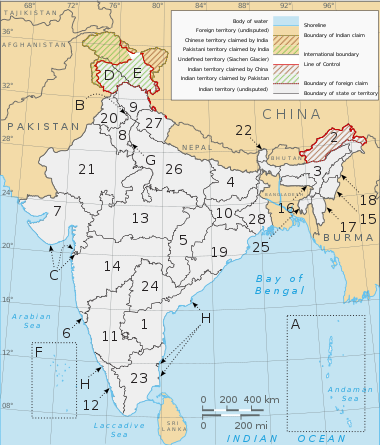
A parliamentary joint session being held in the Sansad Bhavan.
In the Republic of India's first three general elections, in 1951, 1957, and 1962, the Jawaharlal Nehru-led Congress won easy victories. On Nehru's death in 1964, Lal Bahadur Shastri briefly became prime minister; he was succeeded, after his own unexpected death in 1966, by Indira Gandhi, who went on to lead the Congress to election victories in 1967 and 1971. Following public discontent with the state of emergency she declared in 1975, the Congress was voted out of power in 1977; the then-new Janata Party, which had opposed the emergency, was voted in. Its government lasted just over three years. Voted back into power in 1980, the Congress saw a change in leadership in 1984, when Indira Gandhi was assassinated; she was succeeded by her son Rajiv Gandhi, who won an easy victory in the general elections later that year. The Congress was voted out again in 1989 when a National Front coalition, led by the newly formed Janata Dal in alliance with the Left Front, won the elections; that government too proved relatively short-lived, lasting just under two years.[167] Elections were held again in 1991; no party won an absolute majority. The Congress, as the largest single party, was able to form a minority government led by P. V. Narasimha Rao.[168]

The Rashtrapati Bhavan is the official residence of the President of India.
Government
India is a federation with a parliamentary system governed under the Constitution of India, which serves as the country's supreme legal document. It is a constitutional republic and representative democracy, in which "majority rule is tempered by minority rights protected by law". Federalism in India defines the power distribution between the Union, or Central, government and the states. The government abides by constitutional checks and balances. The Constitution of India, which came into effect on 26 January 1950,[176] states in its preamble that India is a sovereign, socialist, secular, democratic republic.[177] India's form of government, traditionally described as "quasi-federal" with a strong centre and weak states,[178] has grown increasingly federal since the late 1990s as a result of political, economic, and social changes.[179][180]| Flag | Tiranga (Tricolour) |
|---|---|
| Emblem | Sarnath Lion Capital |
| Language | None[8][9][10] |
| Anthem | Jana Gana Mana |
| Song | Vande Mataram |
| Currency | ₹ (Indian rupee) |
| Calendar | Saka |
| Animal | Tiger (land) River dolphin (aquatic) |
| Bird | Indian peafowl |
| Flower | Lotus |
| Fruit | Mango |
| Tree | Banyan |
| River | Ganga |
| Game | Not declared[181] |
- Executive: The President of India is the head of state[183] and is elected indirectly by a national electoral college[184] for a five-year term.[185] The Prime Minister of India is the head of government and exercises most executive power.[186] Appointed by the president,[187] the prime minister is by convention supported by the party or political alliance holding the majority of seats in the lower house of parliament.[186] The executive branch of the Indian government consists of the president, the vice-president, and the Council of Ministers—the cabinet being its executive committee—headed by the prime minister. Any minister holding a portfolio must be a member of one of the houses of parliament.[183] In the Indian parliamentary system, the executive is subordinate to the legislature; the prime minister and his council are directly responsible to the lower house of the parliament. The civil servants are permanent executives and all executive decisions are implemented by them. [188]
- Legislature: The legislature of India is the bicameral parliament. It operates under a Westminster-style parliamentary system and comprises the upper house called the Rajya Sabha ("Council of States") and the lower called the Lok Sabha ("House of the People").[189] The Rajya Sabha is a permanent body that has 245 members who serve in staggered six-year terms.[190] Most are elected indirectly by the state and territorial legislatures in numbers proportional to their state's share of the national population.[187] All but two of the Lok Sabha's 545 members are directly elected by popular vote; they represent individual constituencies via five-year terms.[191] The remaining two members are nominated by the president from among the Anglo-Indian community, in case the president decides that they are not adequately represented.[192]
- Judiciary: India has a unitary three-tier independent judiciary[193] that comprises the Supreme Court, headed by the Chief Justice of India, 24 High Courts, and a large number of trial courts.[193] The Supreme Court has original jurisdiction over cases involving fundamental rights and over disputes between states and the centre; it has appellate jurisdiction over the High Courts.[194] It has the power both to declare the law and to strike down union or state laws which contravene the constitution,[195] as well as to invalidate any government action it deems unconstitutional.[196]
Subdivisions
| 1. Andhra Pradesh | 19. Nagaland |
| 2. Arunachal Pradesh | 20. Odisha |
| 3. Assam | 21. Punjab |
| 4. Bihar | 22. Rajasthan |
| 5. Chhattisgarh | 23. Sikkim |
| 6. Goa | 24. Tamil Nadu |
| 7. Gujarat | 25. Telangana |
| 8. Haryana | 26. Tripura |
| 9. Himachal Pradesh | 27. Uttar Pradesh |
| 10. Jammu and Kashmir | 28. Uttarakhand |
| 11. Jharkhand | 29. West Bengal |
| 12. Karnataka | A. Andaman and Nicobar Islands |
| 13. Kerala | B. Chandigarh |
| 14. Madhya Pradesh | C. Dadra and Nagar Haveli |
| 15. Maharashtra | D. Daman and Diu |
| 16. Manipur | E. Lakshadweep |
| 17. Meghalaya | F. National Capital Territory of Delhi |
| 18. Mizoram | G. Puducherry |

